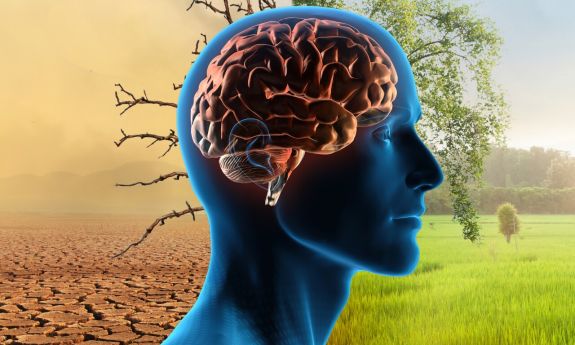Imagine sitting by a window during a relentless heatwave, feeling that knot of worry in your stomach—not just about the sweat dripping down your back, but about what this endless summer means for the world. I’ve been there, staring at cracked earth in my backyard garden that used to burst with life, wondering how these changes sneak into our minds and mess with our peace. It’s moments like these that make the work of the Earth Brain Health Commission feel so personal and urgent. Launched in September 2024, this initiative isn’t just another scientific panel; it’s a call to action for protecting our mental wellbeing amid environmental chaos. In this article, we’ll dive deep into what the commission is, why it matters, and practical ways to safeguard our brains in a world that’s shifting faster than we can keep up.
Understanding the Earth Brain Health Commission
The Earth Brain Health Commission, often abbreviated as EBHC, is a groundbreaking collaborative effort aimed at tackling the invisible toll that environmental changes take on our mental health. Born from the recognition that factors like climate shifts and urban sprawl aren’t just planetary problems but deeply personal ones, the commission brings together experts to chart a path forward. It’s all about preserving mental resilience in an era where the ground beneath us—literally and figuratively—feels unstable.
Origins and Launch of the Commission
Picture a group of scientists, policymakers, and thinkers gathering in Berlin’s historic Hörsaalruine, blending old-world architecture with cutting-edge ideas—that was the launch event on September 17, 2024. Sponsored by Nature Mental Health and tied to the EU-funded environMENTAL project, it marked the start of a mission to integrate technology and interdisciplinary knowledge. The event featured talks on everything from air pollution’s brain effects to AI’s role in disaster management, setting a tone of hope amid growing concerns.
Key Goals and Objectives
At its core, the EBHC seeks to mitigate harms from “environmental megatrends” like pollution and social inequality, focusing on prevention and early intervention for mental illnesses. By organizing scientific knowledge and boosting research, it aims to create global solutions that work for individuals and societies alike. Think of it as a blueprint for turning overwhelming challenges into actionable strategies, ensuring mental health doesn’t get lost in the climate conversation.
The Link Between Environment and Mental Health
We’ve all felt it—that subtle dread when news headlines scream about wildfires or flooding. Research shows environmental stressors can trigger anxiety, depression, and even cognitive decline, as our brains react to threats like rising temperatures or toxic air. The commission highlights how these changes disrupt neural pathways, making preservation not just a nice-to-have but essential for human thriving.
How Climate Change Impacts the Brain
Rising global temperatures don’t just melt ice caps; they heat up our stress responses, leading to “climate anxiety” that keeps people up at night. Studies link extreme weather to increased PTSD rates, with vulnerable communities hit hardest. It’s like the planet’s fever is contagious, seeping into our thoughts and behaviors in ways we’re only beginning to understand.
Pollution and Urbanicity: Hidden Threats
City life, with its constant noise and smog, can rewire the brain toward heightened alertness, fostering conditions like ADHD or mood disorders. Pollution particles sneak past blood-brain barriers, causing inflammation that mirrors aging effects. The EBHC stresses that urban planning must evolve to include green spaces, turning concrete jungles into sanctuaries for the mind.
Social Disparities Amplify the Risks
Not everyone faces these threats equally—low-income areas often bear the brunt of environmental degradation, compounding mental health inequities. Imagine growing up in a polluted neighborhood where every breath feels like a risk; it’s no wonder depression rates soar there. The commission calls for justice-focused approaches, ensuring preservation efforts reach those who need them most.
Strategies to Preserve Mental Health Amid Change
Preserving mental health isn’t about ignoring the chaos; it’s about building tools to navigate it. From daily habits to policy shifts, the EBHC offers a roadmap that blends science with practicality. I’ve tried some myself, like mindful walks in nature during stressful times, and they’ve made a world of difference.
Building Personal Resilience
Start small: Incorporate “green time” into your routine, like gardening or forest bathing, which research shows lowers cortisol levels. Mindfulness apps tailored to eco-anxiety can help reframe worries into action. It’s empowering to know that even in a changing world, simple steps can shield your brain from overload.
Community and Policy-Level Interventions
Communities can create “mental health buffers” through urban greening projects or support groups for climate grief. On a larger scale, policies advocating for clean air standards directly protect brain health. The EBHC urges governments to integrate mental health into environmental agendas, turning potential crises into opportunities for collective wellbeing.
Technological Innovations for Preservation
AI and remote sensing tech, as highlighted by the commission, can predict environmental risks and personalize interventions. Wearable devices tracking stress in polluted areas? That’s the future. By harnessing big data, we can spot patterns early, making preservation proactive rather than reactive.
Pros and Cons of the Commission’s Approach
The EBHC’s interdisciplinary model has clear upsides, but like any ambitious effort, it comes with hurdles. Let’s break it down honestly.
- Pros:
- Fosters collaboration across fields, leading to innovative solutions.
- Emphasizes global applicability, helping diverse populations.
- Integrates tech for scalable, data-driven preservation strategies.
- Cons:
- Requires massive coordination, which can slow progress.
- Funding dependencies might limit reach in under-resourced areas.
- Balancing urgency with ethical data use poses ongoing challenges.
Comparing Environmental Megatrends and Their Mental Health Impacts
To grasp the scope, here’s a table comparing key megatrends identified by the EBHC and their effects:
| Megatrend | Primary Impact on Mental Health | Example Preservation Strategy |
|---|---|---|
| Climate Change | Increases anxiety and PTSD from disasters | Community resilience programs and therapy focused on eco-grief |
| Pollution | Causes cognitive decline and depression | Air quality monitoring apps and advocacy for stricter regulations |
| Urbanicity | Heightens stress and isolation | Urban green space initiatives and mindfulness in city planning |
| Social Disparity | Amplifies inequities in access to care | Targeted interventions in vulnerable communities and policy reforms |
This comparison shows how interconnected these issues are, urging a holistic preservation mindset.
Best Tools and Resources for Preservation
Looking for the best ways to act? Start with apps like Calm or Headspace, which now include modules on environmental stress. For deeper dives, the environMENTAL project’s website offers free resources on brain health. Books like “The Nature Fix” by Florence Williams provide evidence-based tips, while therapy platforms like BetterHelp connect you with eco-focused counselors.
Where to Get Involved or Learn More
Head to the official environMENTAL site (environmental-project.org) for updates and event replays. Nature Mental Health’s articles are goldmines—check their volumes for free abstracts. If you’re in academia, join networks like the commission’s collaborators for webinars and research opportunities.
People Also Ask (PAA) Section
Drawing from common Google queries on this topic, here are real questions people are asking, with concise answers based on EBHC insights.
What is the Earth Brain Health Commission?
It’s a 2024 initiative with 25 experts addressing how environmental changes harm mental health, aiming for tech-driven prevention strategies.
How does climate change affect mental health?
It triggers eco-anxiety, depression, and trauma from events like floods, disrupting sleep and focus through chronic stress.
What are ways to preserve mental health in a changing environment?
Incorporate nature exposure, advocate for green policies, and use apps for stress tracking—small actions build big resilience.
Why is interdisciplinary research important for brain health?
Blending fields like climatology and neuroscience uncovers hidden links, leading to comprehensive solutions that single disciplines miss.
FAQ
What role does technology play in the Earth Brain Health Commission?
Technology is central, from AI for disaster prediction to big data for personalizing mental health interventions, making global preservation feasible.
How can individuals contribute to preserving mental health environmentally?
By reducing personal carbon footprints, joining local eco-groups, and practicing self-care like journaling about climate worries—it all adds up.
Are there ethical concerns with using big data in mental health research?
Yes, privacy and bias are key issues; the EBHC emphasizes ethical protocols to ensure data harmonization benefits everyone without harm.
What makes the EBHC different from other environmental health efforts?
Its focus on brain-specific impacts and interdisciplinary integration sets it apart, bridging earth sciences with psychiatry for targeted outcomes.
Where can I find the latest publications from the commission?
Check Nature Mental Health’s September and October 2024 issues for articles on topics like multi-omics and urban effects.
In wrapping up, the Earth Brain Health Commission reminds us that preserving mental health isn’t a solo journey—it’s a shared one with the planet. I’ve felt lighter since adopting some of their ideas, like turning my anxiety into advocacy for local parks. It’s not always easy; sometimes it feels like pushing against a storm. But with humor—hey, if the earth can handle ice ages, we can handle this—and heart, we can build a future where our minds stay as resilient as the world we cherish. For more on related topics, explore our site’s articles on climate resilience or mental wellness tools. Stay connected, stay preserved.




